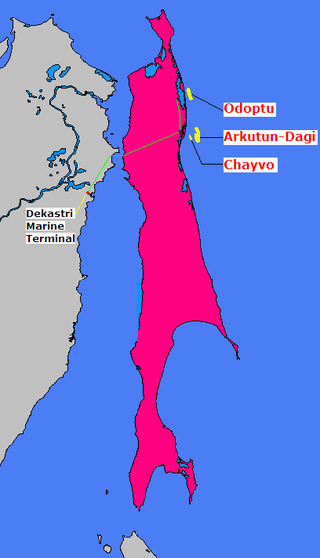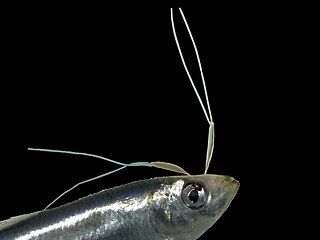
Sakhalin is an island in Northeast Asia. Its north coast lies 6.5 km (4.0 mi) off the southeastern coast of Khabarovsk Krai in Russia, while its southern tip lies 40 kilometres (25 mi) north of Japan's Hokkaido. A marginal island of the West Pacific, Sakhalin divides the Sea of Okhotsk to its east from the Sea of Japan to its southwest. It is administered as part of Sakhalin Oblast and is the largest island of Russia, with an area of 72,492 square kilometres (27,989 sq mi). The island has a population of roughly 500,000, the majority of whom are Russians. The indigenous peoples of the island are the Ainu, Oroks, and Nivkhs, who are now present in very small numbers.

Stomiiformes is an order of deep-sea ray-finned fishes of very diverse morphology. It includes, for example, dragonfishes, lightfishes, loosejaws, marine hatchetfishes and viperfishes. The order contains 4 families with more than 50 genera and at least 410 species. As usual for deep-sea fishes, there are few common names for species of the order, but the Stomiiformes as a whole are often called dragonfishes and allies or simply stomiiforms.

The Sakhalin-I project, a sister project to Sakhalin-II, is a consortium for production of oil and gas on Sakhalin Island and immediately offshore. It operates three fields in the Okhotsk Sea: Chayvo, Odoptu and Arkutun-Dagi.

Karafuto Agency, from 1943 Karafuto Prefecture, commonly known as South Sakhalin, was a part of the Empire of Japan on Sakhalin, it was part of the gaichi from 1907 to 1943 and later a prefecture as part of the naichi until 1945.

The Pacific viperfish, Chauliodus macouni, is a predatory deep-sea fish found in the North Pacific. It is reported as being either mesopelagic or bathypelagic, with diel vertical migration to shallower waters. The Pacific viperfish is one of the nine different species that belong to the genus Chauliodus, the viperfish. The Pacific viperfish tend to be the largest of the species, typically reaching lengths of up to 1 foot and are considered an example of deep-sea gigantism. The length-weight relationship of the pacific viperfish varies with sex with females tending to be longer and heavier than males.

Weevers are nine extant species of fishes of family Trachinidae, order Trachiniformes, part of the Percomorpha clade. They are long, mainly brown in color, and have venomous spines on their first dorsal fin and gills. During the day, weevers bury themselves in sand, just showing their eyes, and snatch prey as it comes past, which consists of shrimp and small fish.

A viperfish is any species of marine fish in the genus Chauliodus. Viperfishes are mostly found in the mesopelagic zone and are characterized by long, needle-like teeth and hinged lower jaws. A typical viperfish grows to lengths of 30 cm (12 in). Viperfishes undergo diel vertical migration and are found all around the world in tropical and temperate oceans. Viperfishes are capable of bioluminescence and possess photophores along the ventral side of their body, likely used to camouflage them by blending in with the less than 1% of light that reaches to below 200 meters depth.

Stomiidae is a family of deep-sea ray-finned fish, including the barbeled dragonfishes. They are quite small, usually around 15 cm, up to 26 cm. These fish are apex predators and have enormous jaws filled with fang-like teeth. They are also able to hinge the neurocranium and upper-jaw system, which leads to the opening of the jaw to more than 100 degrees. This ability allows them to consume extremely large prey, often 50% greater than their standard length.

Sloane's viperfish, Chauliodus sloani, is a predatory mesopelagic dragonfish found in waters across the world. The species was first described by German scientists Marcus Elieser Bloch and Johann Gottlob Schneider in their 1801 book Systema ichthyologiae: iconibus CX illustratum, volume 1. Female C. sloani reach maturity between 133 and 191 mm, while males likely reach maturity at slightly smaller body lengths. It has two rows of photophores along its ventral side. It is believed that C. sloani can adjust the intensity of bioluminescence of the ventral photophores to camouflage itself from predators that might see its shadow from below.

Chauliodus danae, or dana viperfish, is a species of viperfish in the family Stomiidae. The Dana Viperfish is mostly found in the bathyal zone. The species was first caught and recognised on the Dana expeditions 1920-1922 and named after the research vessel Dana.
Chauliodus vasnetzovi is a species of viperfish in the family Stomiidae, first discovered in 1972. It is generally found in the Bathypelagic zone in the Southeast Pacific near Chile and can grow to be up to 32.5 centimetres (12.8 in) long.

Pennellidae is a family of parasitic copepods. When anchored on a host, they have a portion of the body on the outside of the host, whereas the remaining anterior part of the parasite is hidden inside tissues of the host.

Aplatophis chauliodus, the fangtooth snake-eel, also known as the tusky eel in Cuba and the United States, is an eel in the family Ophichthidae. It was described by James Erwin Böhlke in 1956. It is a marine, tropical eel known from the western Atlantic Ocean, including the Gulf of Mexico and French Guiana. It is also known to occur on the northeastern coast of Brasil. It dwells at a depth range of 33–91 m (100–300 ft), and dwells in both marine waters and brackish estuaries. It inhabits burrows on a permanent or semipermanent basis, and leaves its eyes and snout exposed. Males can reach a maximum total length of 84 cm (33 in). The fangtooth snake-eel's diet consists of bony fish and crustaceans.

Chauliodus eximus, originally described in 1925 as Eostomias eximus, is an extinct viperfish in the family Stomiidae from marine Late Miocene-aged strata of Southern California.
Astronesthes richardsoni, or Richardson's snaggletooth, is a species of small, deep sea fish in the family Stomiidae. It occurs in the tropical western Atlantic Ocean, the Caribbean Sea and the Gulf of Mexico. First described by the Cuban zoologist Felipe Poey in 1852, it was named Chauliodus richardsoni in honour of the Scottish explorer and naturalist John Richardson. It was later transferred to the genus Astronesthes.

Protosarcotretes is a genus of marine copepods in the family Pennellidae. Its type-species is Protosarcotretes nishikawai. This genus exhibits the most plesiomorphic states in the first to fourth legs of pennellids, and is differentiated from two closely related pennellid genera Sarcotretes and Lernaeenicus by the morphology of the oral appendages.
Stomias affinis, also known as Gunther's boafish, is a deep-sea mesopelagic fish species in the family Stomiidae. They inhabit the open seas in the equatorial zones of the Atlantic, Indian and Pacific Oceans.
Melanostomias dio is a species of ray-finned fish from the family Stomiidae. It's native to the Western Atlantic, being more restricted to Fernando de Noronha Archipelago, in Brazil. in its scientific name, pays homage to the metal singer Ronnie James Dio, because the shiny lure located below the mouth, is very similar to a hand signal that heavy metal fans and musicians use.












